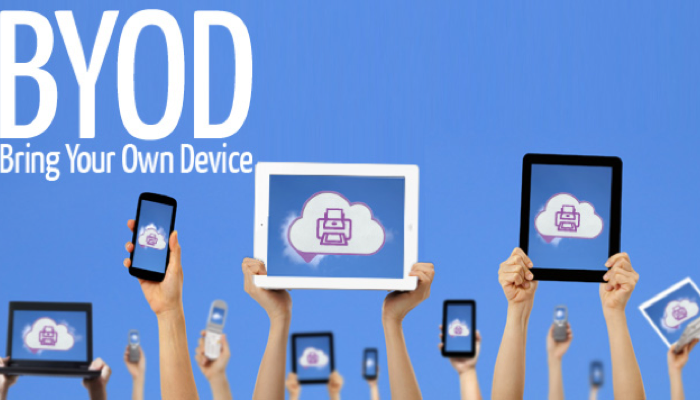The evolution of BYOD

In the 1980s, email remained a luxury for a small number of larger organizations and universities. Mobile email did not exist. Instead, pagers and cellular telephones were the primary tools for mobile communication. However, in the early 1990s, email rose to prominence with the commercialization of the Internet. Although early smartphones did exist at this time (e.g. IBM’s Simon), email was not considered a mobile technology.
But by the mid 1990s, the computing landscape had exploded. PCs spread across companies like a virus, and productivity software like Microsoft Office became standard practice. Email quickly rose to prominence, and was the primary method for communication within companies by the late 1990s. Microsoft Outlook (part of Microsoft Office) allowed you to send and receive emails internally or across the internet via your company’s Microsoft Exchange Server (which is still the dominant email server today).
RIM wireless pagers (later called BlackBerry devices) became a luxury commodity for those executives that wanted to access their email via wireless cellular networks. However, each person with a BlackBerry had to ensure that their PC was always turned on and connected to the Internet, and that both Outlook and the BlackBerry Desktop Redirector program was running. The BlackBerry Desktop Redirector essentially talked to the servers at RIM, which relayed email to and from your BlackBerry.
By year 2000, both email and calendaring became vital tools in nearly all companies, and accessing email remotely quickly became a desired feature for those that needed to work out of the office on several occasions (e.g. executives, marketing, sales people, and so on.). The primary tools at this time for mobility included a cell phone and a laptop computer. You could access email and calendaring information easily using a laptop computer, but connectivity to the Internet in order to do so was cumbersome at best since Wi-Fi networks were relatively rare until the late 2000s (as a result, laptops were still manufactured with 56K modems well into the late 2000s to allow people to obtain a dial-up connection to their company if a Wi-Fi or wired Internet connection was not available).
On the mobile front, RIM outfitted their BlackBerry devices with a cell phone, called it a smartphone, and marketed it to companies as an all-in-one mobile productivity device. While still quite pricey at the time, it saw massive success during the entire decade, partly due to BlackBerry Enterprise Server (BES). Rather than connecting across the Internet directly to the BlackBerry Desktop Redirector software running on an Outlook PC (via the servers at RIM), all BlackBerry devices connected directly to the BES server in the organization, which directly interfaced with Microsoft Exchange Server. This meant that email was redirected to and from the mailbox on your Exchange server to your BlackBerry smartphone without having to rely on Outlook. Additionally, having a central BES server allowed for tight restrictions of content and settings on the smartphone via custom policies that you could create on the BES server itself. The only downside? BES and BlackBerrys were still very expensive.
Security has always been, and will always be on the tip of every IT manager’s tongue, as no system can be 100% secure, and losing data scares people at every level within an organization. Since BlackBerry smartphones used encryption when sending data, and could be centrally managed and locked down using BES, it was widely considered to be the most secure platform for mobile email and calendaring. Consequently, there were no real competitors in that space for most of the decade, and RIM was given free rein when setting the tone for corporate mobile access to email and calendaring information. More specifically, the focus that they pushed regarding mobile access has been to “restrict and secure” it.
But this “restrict and secure” mentality fell victim to the Bring Your Own Device (BYOD) paradigm shift a few years later….
Starting in the mid-2000s, people started using the Internet for media sharing and social networking (MySpace, Facebook, Twitter), and it only made sense that those needs translated to the mobile space. RIM started releasing smartphones geared towards consumers, but other players started to enter the market – notably iPhone and Android, which were fully-featured ARM-based computers that could run apps that enriched the growing Internet experience. Cameras became standard smartphone features and wireless data technologies were developed at a much more rapid pace to give smartphones faster Internet access.
Non-BlackBerry smartphones, such as the iPhone and Android smartphones, could connect easily and securely to any Microsoft Exchange Server as long as you supplied your work username and password when setting up the account. Almost overnight, the paradigm of the “smartphone as a corporate device” died, and was replaced by the current paradigm of “the smartphone as a mobile computer”. People could buy a smartphone and use it to take pictures, play their music, run apps, play games, and access their corporate email and calendar using the secure HTTPS protocol. To users, smartphones were personal devices that allowed you to manage your home and work life, and to IT managers, smartphones were functionally just like a user’s home computer.
By this time, most organizations allowed their employees to check email and calendaring remotely from home using the Outlook and the Outlook Web Access website (later called Outlook Web App), so allowing remote access to email on smartphones was a small decision. Moreover, since you can optionally restrict and wipe the data from smartphone devices remotely from a Microsoft Exchange Server, there were no major security and management concerns in doing so.
It ushered in the age of BYOD, which is sometimes called the “consumerization of IT” as it allows users to use their own devices to check their corporate email and calendar appointments, while the company simply provides the email server infrastructure to do it. Users treat their smartphone as their own personal mobile computer, and IT managers simply allow secure remote access to users so that they can check their email anywhere!